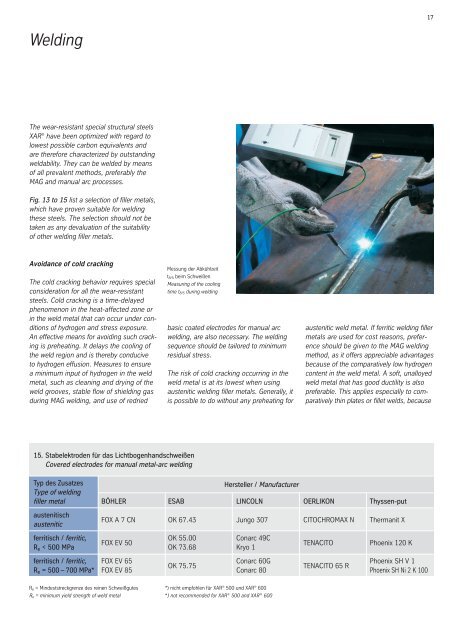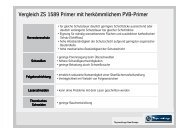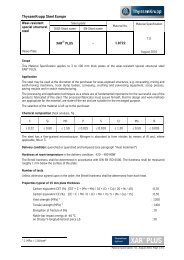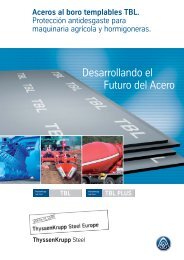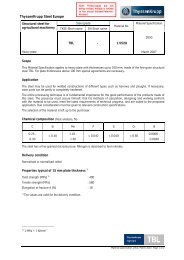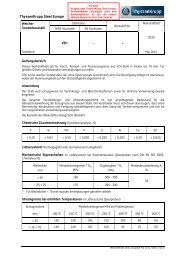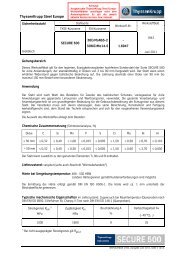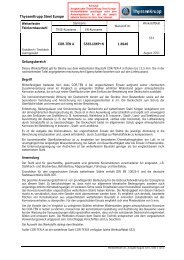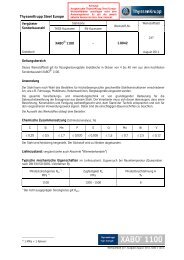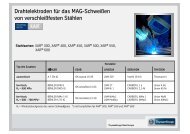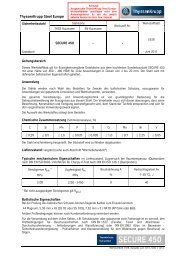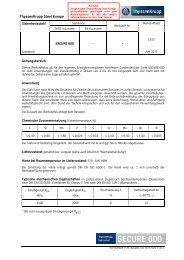Verarbeitung XAR
Verarbeitung XAR
Verarbeitung XAR
Sie wollen auch ein ePaper? Erhöhen Sie die Reichweite Ihrer Titel.
YUMPU macht aus Druck-PDFs automatisch weboptimierte ePaper, die Google liebt.
Welding<br />
The wear-resistant special structural steels<br />
<strong>XAR</strong> ® have been optimized with regard to<br />
lowest possible carbon equivalents and<br />
are therefore characterized by outstanding<br />
weldability. They can be welded by means<br />
of all prevalent methods, preferably the<br />
MAG and manual arc processes.<br />
Fig. 13 to 15 list a selection of filler metals,<br />
which have proven suitable for welding<br />
these steels. The selection should not be<br />
taken as any devaluation of the suitability<br />
of other welding filler metals.<br />
Avoidance of cold cracking<br />
The cold cracking behavior requires special<br />
consideration for all the wear-resistant<br />
steels. Cold cracking is a time-delayed<br />
phenomenon in the heat-affected zone or<br />
in the weld metal that can occur under conditions<br />
of hydrogen and stress exposure.<br />
An effective means for avoiding such cracking<br />
is preheating. It delays the cooling of<br />
the weld region and is thereby conducive<br />
to hydrogen effusion. Measures to ensure<br />
a minimum input of hydrogen in the weld<br />
metal, such as cleaning and drying of the<br />
weld grooves, stable flow of shielding gas<br />
during MAG welding, and use of redried<br />
Messung der Abkühlzeit<br />
t8/5 beim Schweißen<br />
Measuring of the cooling<br />
time t8/5 during welding<br />
15. Stabelektroden für das Lichtbogenhandschweißen<br />
Covered electrodes for manual metal-arc welding<br />
basic coated electrodes for manual arc<br />
welding, are also necessary. The welding<br />
sequence should be tailored to minimum<br />
residual stress.<br />
The risk of cold cracking occurring in the<br />
weld metal is at its lowest when using<br />
austenitic welding filler metals. Generally, it<br />
is possible to do without any preheating for<br />
Re = Mindeststreckgrenze des reinen Schweißgutes *) nicht empfohlen für <strong>XAR</strong> ® 500 und <strong>XAR</strong> ® 600<br />
Re = minimum yield strength of weld metal *) not recommended for <strong>XAR</strong> ® 500 and <strong>XAR</strong> ® 600<br />
17<br />
austenitic weld metal. If ferritic welding filler<br />
metals are used for cost reasons, preference<br />
should be given to the MAG welding<br />
method, as it offers appreciable advantages<br />
because of the comparatively low hydrogen<br />
content in the weld metal. A soft, unalloyed<br />
weld metal that has good ductility is also<br />
preferable. This applies especially to comparatively<br />
thin plates or fillet welds, because<br />
Typ des Zusatzes Hersteller / Manufacturer<br />
Type of welding<br />
filler metal BÖHLER ESAB LINCOLN OERLIKON Thyssen-put<br />
austenitisch<br />
austenitic<br />
FOX A 7 CN OK 67.43 Jungo 307 CITOCHROMAX N Thermanit X<br />
ferritisch / ferritic,<br />
OK 55.00 Conarc 49C<br />
FOX EV 50<br />
Re < 500 MPa OK 73.68 Kryo 1<br />
TENACITO Phoenix 120 K<br />
ferritisch / ferritic, FOX EV 65<br />
Conarc 60G<br />
Phoenix SH V 1<br />
OK 75.75<br />
TENACITO 65 R<br />
Re = 500 – 700 MPa* FOX EV 85 Conarc 80 Phoenix SH Ni 2 K 100


